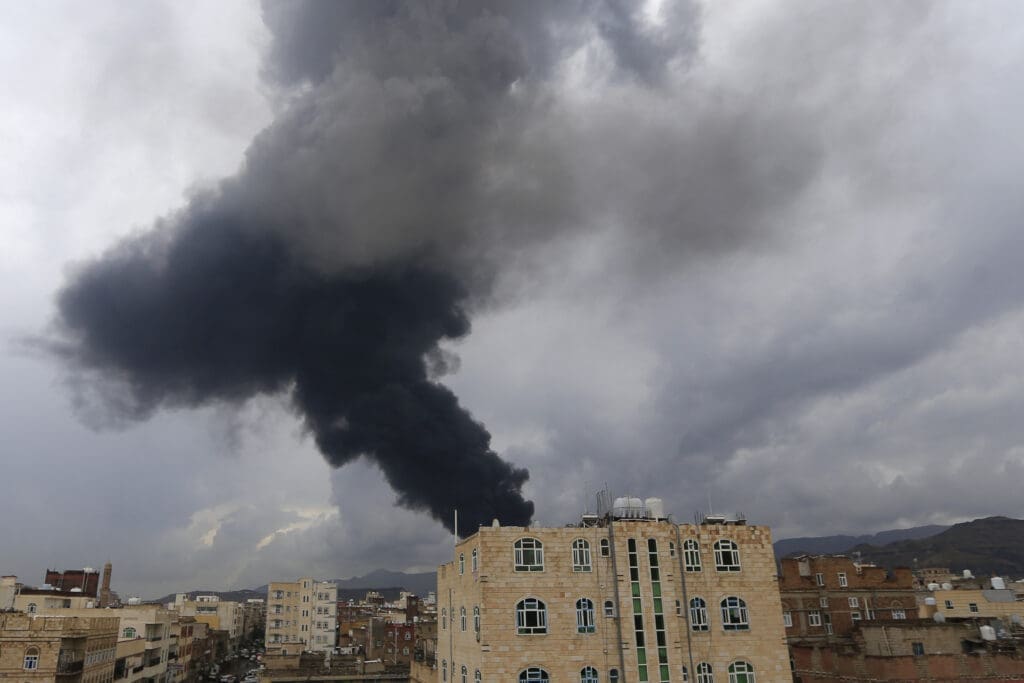Late last month, the residents of Sana’a witnessed something new. Although the smoke billowing over the Yemeni capital’s skyline was familiar for those who have experienced their fair share of war, the villa from which it emanated had been hosting a gathering of Houthi government ministers. An Israeli air raid had attacked the location, killing Houthi Prime Minister Ahmed Ghalib al-Rahwi and several other ministers. The unprecedented air strike against top civilian political officials was the culmination of days of mutual escalation that began earlier in the week, when Houthi forces launched a new ballistic cluster missile toward Israel, which bypassed the country’s Iron Dome defense system and struck the outskirts of Tel Aviv. Although the two sides have engaged in tit-for-tat fighting for the better part of two years, the latest exchange signaled that a dangerous intensification appears to have started.
From cluster missiles to the strike on Sana’a
The Houthi strike on Israel on August 22 involved the group’s first documented use of a ballistic missile equipped with a cluster warhead. This made interception a complex feat even for Israel’s multi-layered defense network. Sirens sounded in several areas of the country when the missile entered its airspace, and Ben Gurion International Airport was shut down for hours. Although the missile did not cause significant harm, the rare breach of Israel’s defense umbrella was symbolically damaging and prompted Israeli decision-makers to respond forcefully. On August 24, the Yemeni capital was rocked by explosions targeting vital sites, including the presidential compound, a power station and an oil facility that erupted into flames. At least 10 civilians were killed and dozens were wounded.
However, the more significant strike came four days later, when Israel gathered information on a meeting of the Houthi government. Although Israeli intelligence was not well-informed on the Houthis before October 7, 2023, they have been ramping up their capabilities in recent months. According to local accounts, the strike came while Houthi ministers were gathered to watch a live broadcast of a speech by their leader, Abdul-Malik al-Houthi, as he vowed revenge against Israel for the earlier attacks.
Security breach or investment in fragility?
The Houthis’ recent success in breaching Israeli defenses raises new questions about shifting military dynamics in the region: was it merely a temporary lapse, or does it expose a deeper, long-term fragility? This is not the first time Houthi fire has reached the heart of Israel. Over the past two years, the Houthis have launched dozens of missiles and drones toward Israel, most of which were intercepted or fell short of their targets. Exceptions include a drone strike in July 2024 that hit a building near the U.S. Embassy in Tel Aviv, killing and injuring civilians, and a ballistic missile in May 2025 that landed near Ben Gurion Airport, causing damage and temporarily disrupting flights.
What distinguishes the latest strike is the use of a cluster warhead a missile that explodes midair, releasing multiple submunitions that confuse Iron Dome and Arrow radars and render interception almost impossible. This technological development touches a critical weak point in Israel’s defense systems. From the Houthis’ perspective, the very fact that a missile reached the outskirts of Tel Aviv represents both a military and propaganda achievement, a message that their long arm is capable of traversing distances and overcoming fortifications through advanced technology.
In the background stands Iran, the incubator of this technology, signaling through its ally that it holds undisclosed capabilities that could be deployed in any future confrontation with Israel. For Israel, the incident might be viewed as a passing technical failure, the result of multiple simultaneous threats or system malfunctions. Yet the frequency and variety of Houthi attacks suggest a steadily ascending trajectory in their capabilities. Each successful strike grants them operational experience and political leverage, compelling Tel Aviv to reconsider its defensive strategies.
The conflict has thus evolved into a symbolic battle over Israel’s image as a state capable of protecting its home front. For the Houthis, it is enough that fragments fall on the outskirts of Tel Aviv for the event to be proclaimed a political and moral victory regardless of the actual scale of physical damage.
On the other hand, the latest Israeli strike leaves less room for interpretation. Since beginning its operations against the Houthis about a year ago, Israel had followed a relatively consistent pattern: targeting infrastructure and vital facilities and, at times, attempting to assassinate prominent military leaders. This pattern led the Houthis to expect that Israeli actions would remain within certain boundaries. The August 28 attack, however, altered the equation. It was not confined to military or logistical civilian sites, but was instead designed to collapse the Houthis’ administrative structure from the very top.
In doing so, Israel sent a double message. To the Houthis, it signaled a departure from the presumed rules of engagement. To the broader region, it declared that there would no longer be any distinction between civilian and military targets, no red lines in future battles, and no individual beyond reach. This shift was confirmed in practice shortly thereafter with the Doha strike, which underscored Israel’s willingness to extend its campaign beyond traditional limits.
Motivation for continued conflict
Predictably, the escalation by both sides has settled into another round of conflict. Hours after Sana’a held a funeral for its prime minister and his colleagues on September 1, the Houthis announced that they had targeted an oil tanker in the Red Sea near the Saudi port of Yanbu as an initial response to the assassination. While the ship was flying a Liberian flag, it was Israeli-owned.
In response, Israel vowed a more violent reprisal, asserting that any Houthi attack would be met with a double escalation. This tit-for-tat reflects a vicious cycle of revenge: a Houthi strike provokes a larger Israeli response, and then the Houthis escalate again. As such, the conflict has shifted from being a front supporting Gaza to a war in its own right, fueled by a mixture of revenge and symbolism. The Houthi leadership now finds itself with a secondary incentive to continue: Attacking Israel is no longer just a matter of satisfying its base, which believes in the demonstration of support for Gaza, but also of direct revenge for its leaders who fell in Sana’a. Israel, for its part, views the Houthis as Iran’s proxy in a regional war, which calls for an open deterrence strategy based on responding to every attack with a more severe operation, in the hope of dampening the Houthis’ appetite for escalation.
However, these calculations put the two sides on a path to a long-term conflict. The Houthis have clearly stated that the truce agreement they signed with Washington months ago does not include Israel, meaning that their operations will continue regardless of any other settlements. With no solution in sight in Gaza, we appear to be facing a low-intensity but ongoing war of attrition: The Houthis strike when they have the opportunity to send political and propaganda messages, and Israel responds forcefully whenever circumstances and intelligence allow.
As a result, both sides have become prisoners of the logic of escalation, with each finding in the other’s actions an incentive for further confrontation. Between a Houthi rocket piercing the skies over Tel Aviv and an Israeli strike bombing Sana’a, it seems that the war between Israel and the Houthis has entered a new phase from which it will be difficult to retreat unless the situation changes radically. Strategic calculations overlap with ideological motives, and the flames of war are unlikely to subside in the foreseeable future as long as the embers remain smoldering in both Gaza and Yemen.
The opinions expressed in this article are those of the author and do not necessarily reflect the views of the Middle East Council on Global Affairs.


